Waltons ultimate guide to buying a playhouse

Image: 7 x 5 Double Storey Swiss Cottage Playhouse from Waltons
Every child would love a playhouse of their own – somewhere to hide out and play, come rain or shine. But with so many styles and features out there, how do you choose the perfect playhouse for your family?
We’ve put together this guide to help you find just what you’re looking for. We’ll talk you through all the options and give detailed advice on everything from choosing the right materials and roof type, to assembly and maintenance considerations.
If you’re thinking about buying a playhouse for your children, read this guide now.
Contents:
- Why buy a playhouse?
- Choose the right playhouse
- Building your playhouse
- Assembly
- Decoration
- Maintenance
Why buy a playhouse?
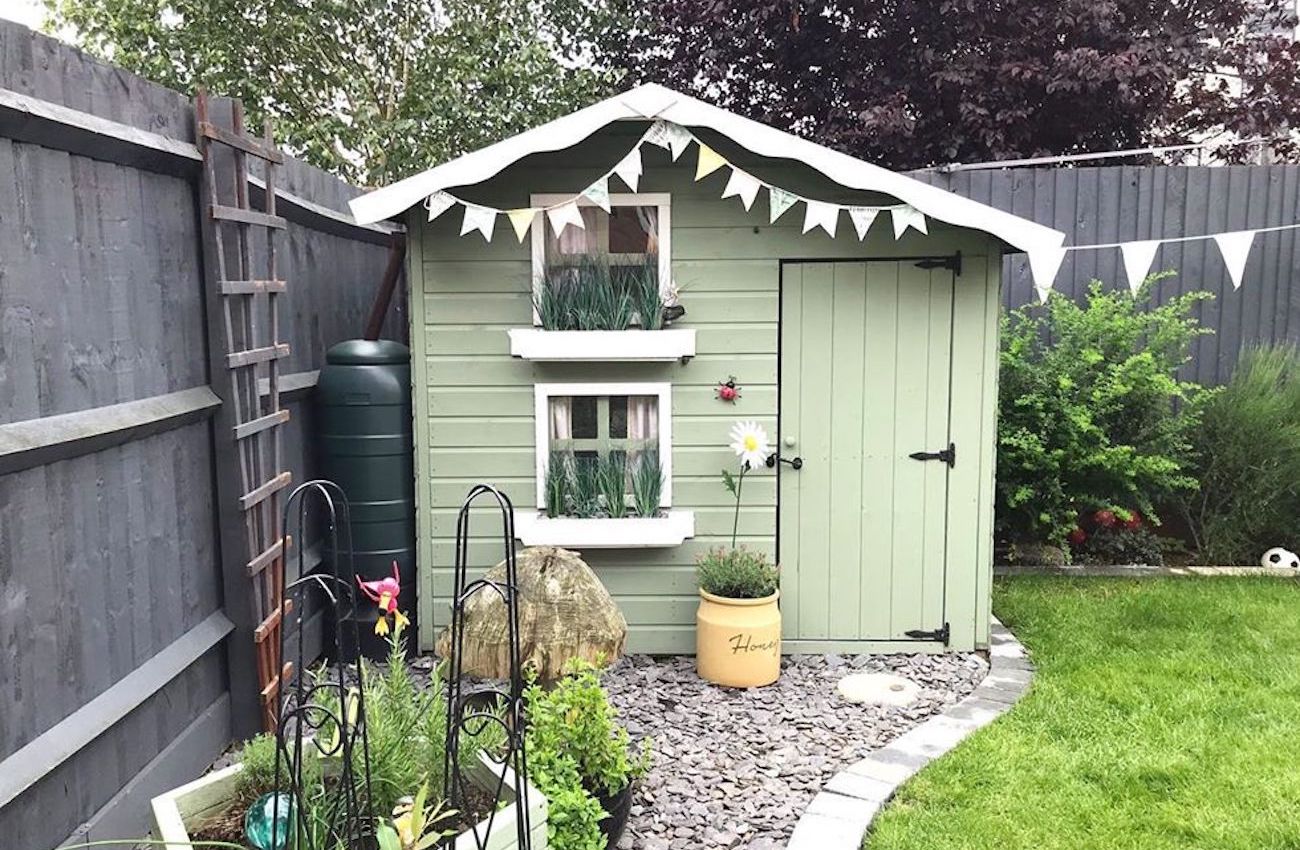
Customer image: @lifeonhathersage
Believe us: buying the right playhouse will transform your life... Imagine you have the perfect playhouse in your garden. Your children spend hours outside, playing happily together, expanding their imaginations. They spend less time glued to the TV or swiping the screen of a tablet or smartphone.
Your children are happier, fitter and healthier, thanks to all that running around outside. You’re happier and calmer because at last the kids have somewhere to go and burn off all their energy. Buying a playhouse is a win-win for the whole family.
Choose the right playhouse
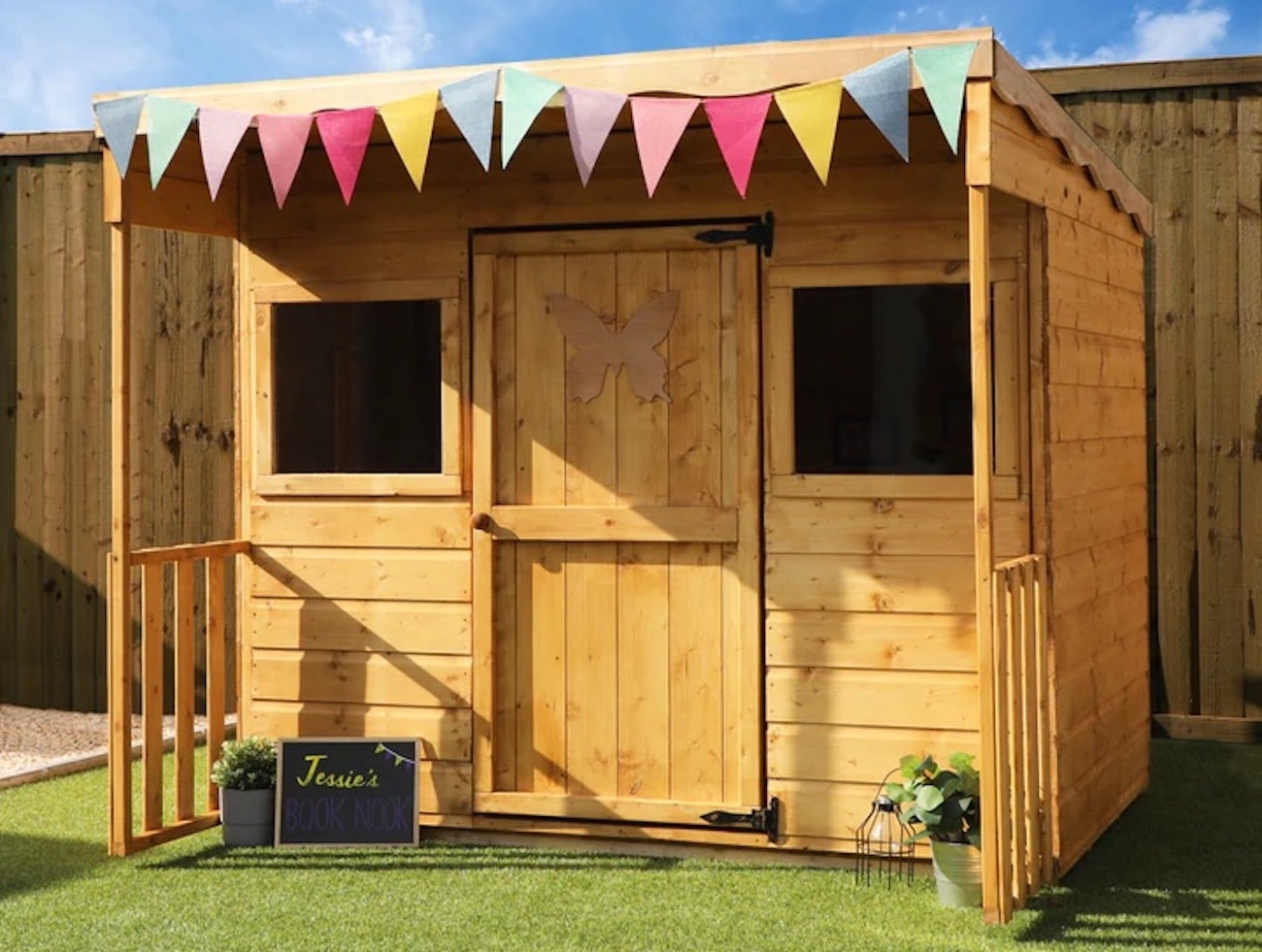
Image: Dahlia Playhouse from Waltons
Before you decide on a playhouse, consider all the options available to you. Here we’ll go through the following points:
- Materials
- Roof type
- Size and height
- Design features
- Additions
- Safety features
- Quality
- Where to put it
- Planning permission
1. Materials
Outdoor playhouses need to be robust enough to withstand the elements, narrowing your choice of materials to either wood or plastic.
- Wooden playhouses look great, are long-lasting and are easy to put up. They tend to be larger than plastic playhouses so will last your children for many years rather than just a couple of seasons. They do require regular maintenance. But it’s easy to customise a wooden playhouse while looking after it – meaning this year’s pink princess castle can become next year’s undercover superhero hideout, with just a lick of paint.
- Plastic playhouses are also easy to put up. They are generally smaller than wooden playhouses, with a lower head-height, meaning they’re best suited to very small children and are quickly outgrown. Plastic playhouses come in a range of bright colours, but these will fade in the sun and a plastic playhouse can soon look tired. They are easily cleaned with a pressure washer and require no maintenance. Made of solid, interlocking plastic panels, once cracked, they are difficult to repair.
Use the comparison table below to determine which playhouse material would best suit you:
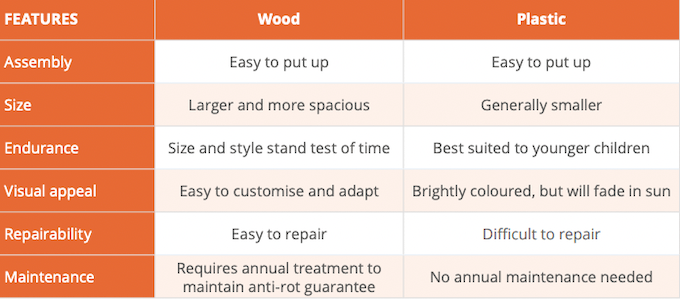
2. Roof type
When it comes to picking a roof type for your playhouse, there’s more to consider than just appearance. Think about height – how tall does it need to be so your kids won’t outgrow it too quickly? Do you need extra storage space for toys? Is there anything in your garden that will restrict the height of the playhouse?
Waltons playhouse roofs fall into these two categories: apex, or Dutch-barn.
- Apex roofs have a traditional ‘A’ shape appearance with two panels sloping side to side, or front to back. They give plenty of headroom and allow rain to run off freely.
- Dutch-barn roofs have a unique shape with four panels creating an arched shape. This provides plenty of headroom throughout the playhouse.

3. Size and shape
Playhouses come in many different shapes and sizes. Bigger is generally better, especially if you want your kids to use the playhouse for years to come. It’s worth considering where you’re going to position the playhouse (see the ‘Where to put it’ section later on in this guide) and then choosing the biggest playhouse you can afford. Some of the most popular shapes of playhouse include: traditional, tower, and two-storey.
- Traditional playhouses are classic one-storey buildings. They work well in smaller gardens and courtyards. And without stairs or ladders to worry about, traditional playhouses are perfect for younger children.
- Tower playhouses are elevated off the ground on stilts. Children access the playhouse by an external ladder and enjoy a great view from up top. Tower playhouses are very popular as they provide a large underneath space that can be used for toy storage or as a shaded play area.
- Two-storey playhouses are split over two floors accessed via an internal ladder. The upstairs ‘room’ is slightly smaller than the ground floor, and the overall height of the building is taller than a single storey model.
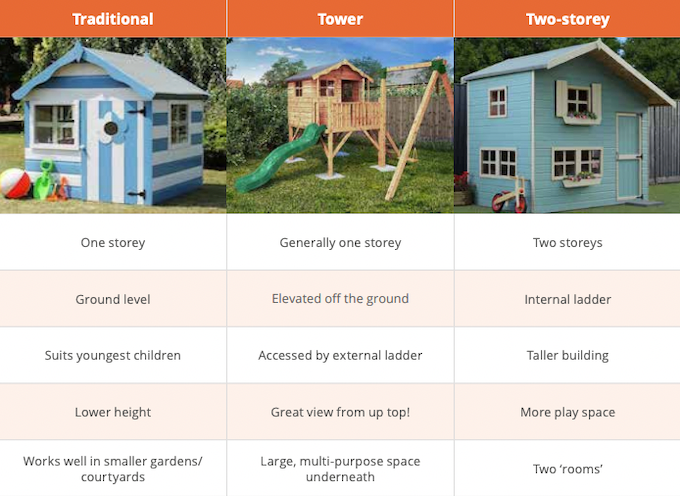
4. Design features
Now it’s time to consider any other design features you want in a playhouse – things like windows and shutters, doors, verandas and raised balconies.
- Windows and shutters: All playhouses will have some form of window to allow light into the building. Some have open spaces for windows that can let in rain and wind. Integral shutters can help keep out the elements. Glazed windows allow light in while keeping bad weather out, thus keeping the playhouse comfortable all year round. If you would prefer glazed windows, we’d advise shatterproof plastic windows instead of traditional glass for safety reasons.
- Door: A playhouse with a closable door will be warmer and drier. A good playhouse should have at least a one-inch gap between door and frame to prevent little fingers from getting trapped.
- Veranda: If you have the space, you might want a playhouse with a veranda. This sheltered outdoor area makes the playhouse feel roomier and allows little ones to get some fresh air even on rainy days.
- Balcony: Two-storey and tower playhouses often come with a raised safety balcony. Railings keep children safe while they enjoy a bird’s-eye view of their outdoor kingdom.
- Unique: A Dutch barn, pirate or even a hobbit house provides even more fuel for fertile imaginations while retaining all the safety features of the traditional playhouses.
5. Additions
You might want to think about adding a slide or activity centre to your playhouse. These add-ons work best with tower playhouses. Adding a slide turns the playhouse into a playground, while an activity centre incorporates a slide and swing.
These will help your kids get the outdoor exercise they need to be fit, healthy and happy. Having all the outdoor play equipment together in one place also frees up the rest of your garden for you.
6. Safety features
There’s no compromise on playhouse safety. To keep your children safe, you need a playhouse that ticks all of these boxes:
- safety hinges on doors
- smoothed and planed timbers to prevent splinters
- shatterproof styrene windows
- non-slip ladders
- 12mm gap around doors to prevent trapped fingers
- meets EN71 Safety Testing Standards
7. Quality
A good-quality playhouse will last you for years to come. Try to source the best quality playhouse you can for your budget. Here are some things to consider:
- Wooden playhouses should come treated and the wood should have a long (10-year) anti-rot guarantee. Look for shiplap tongue-and-groove cladding which creates a strong, weatherproof panel, and planed timber throughout to prevent splinters. Double-framed corners and sturdy floor joists give strength and stability to the playhouse, while a solid roof and floor creates a waterproof barrier.
- Plastic playhouses should be UV-protected to minimise external colour fading. Plastic playhouses vary in weight and stability. You don’t want a playhouse so flimsy it blows over in heavy winds or topples over with children inside. Choose a playhouse that’s sturdy enough to stay outside all year long.
Use the table below to review some quality indicators for wooden and plastic playhouses:
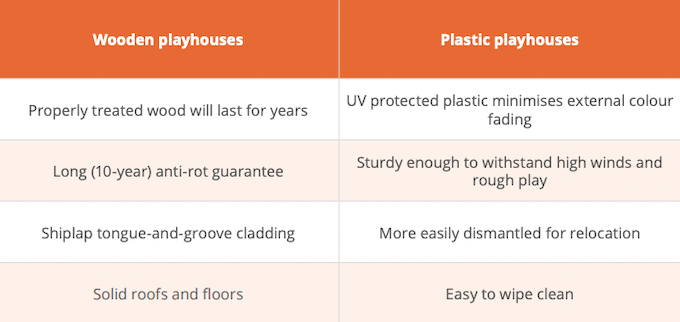
8. Where to put your playhouse

Find a good spot in your garden with enough space to create a level base. Try to leave at least a 3ft gap around the playhouse so you can assemble and maintain it with ease. With a site in mind, you can work out what size playhouse to order. Go for the largest size that space and budget will allow to make sure your children can enjoy it for as long as possible.
9. Planning permission
It’s unlikely you will need to get planning permission for your new playhouse. But always check with your local planning office to make sure. Our guide to garden planning permission will help you along your way.
Building your playhouse
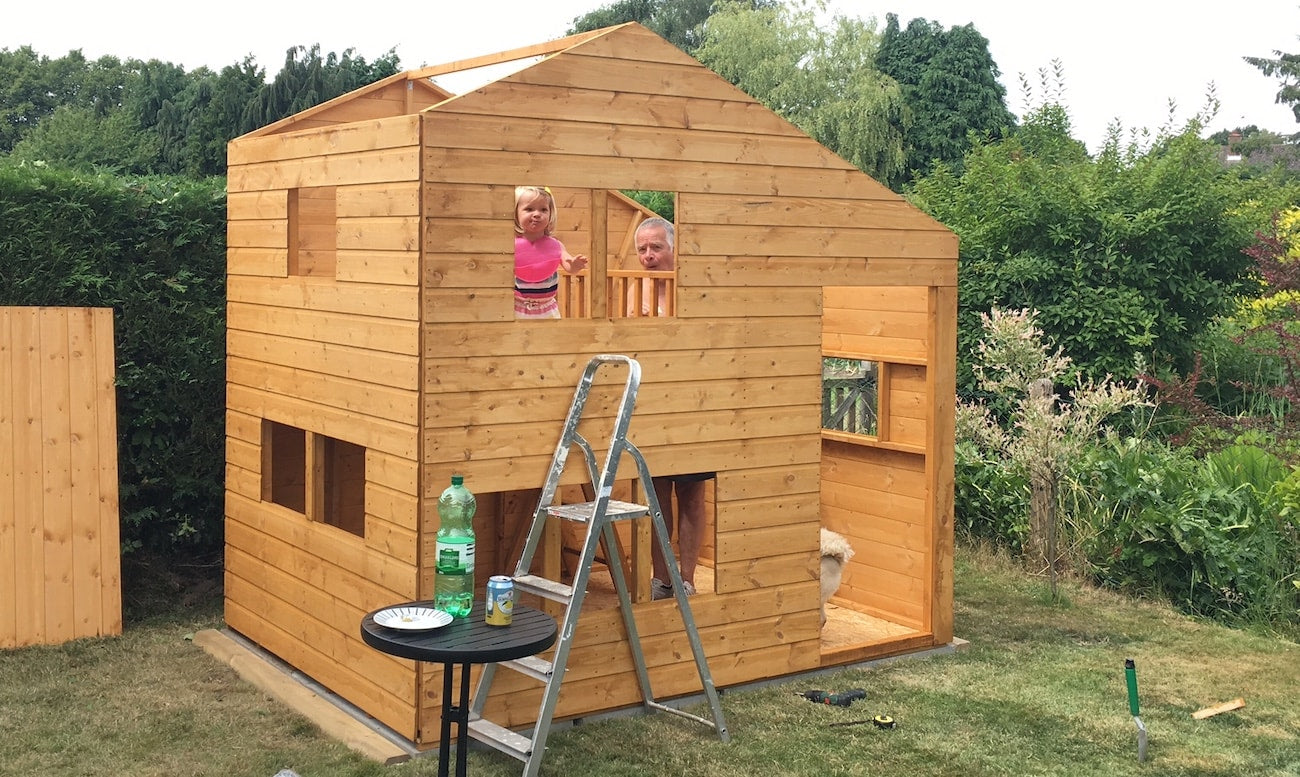
Customer image: Mark Harris
You’ve chosen your perfect playhouse and found the best place in your garden to site it. But before you get out the power tools, get yourself properly prepared. This next section looks at assembly, decoration and maintenance.
1. Assembly
- Help: Whether you choose a wooden or plastic playhouse, you will need two adults for construction as panels can be heavy. If you’re buying from Waltons, you can book our installation service and let our team do it for you.
- Base: A level, flat base is essential. Without a level base, doors and screw holes may not align, windows can be damaged, and your playhouse will be vulnerable to rot and subsidence. Use a spirit level to ensure your wood, paving or concrete base is completely level. See our How to build a shed base guide for more on this.
- Parts: Check the pack and make sure you have all the parts listed.
- Instructions: Always follow the assembly instructions that come with your playhouse.
- Tools: The instructions will list the tools you need. You may require some or all of the following: a Phillips screwdriver, Stanley knife, wood saw, step ladder, and drill with 2mm bit.
Top tip: Pre-drill any screw holes to make construction easier, and to avoid splitting timbers.
2. Decoration
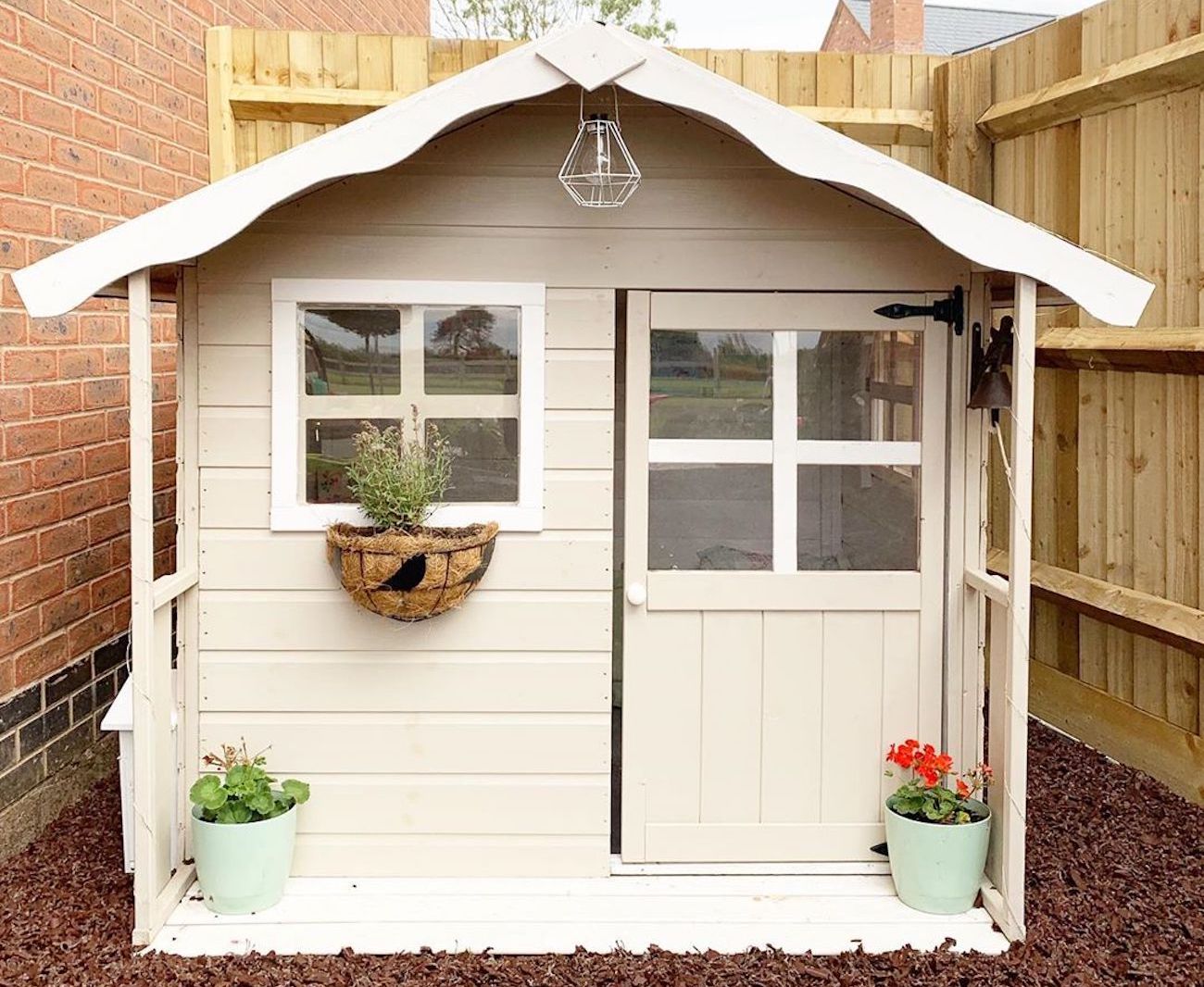
Customer image: @country_brick's 5 x 5 Poppy Wooden Playhouse from Waltons
Decorating a new playhouse can be a lot of fun, particularly when it comes to wooden playhouses, which are a blank canvas for your children’s imaginations. Here are some tips to make your playhouse one of a kind:
- Get the kids involved: Unless you’re planning a surprise project, encourage your children to help design their new space. Depending on their age they might want to draw some pictures of their dream playhouse, look on Pinterest for ideas, or take some inspiration from Waltons playhouse owners.
- Paint the outside: Wooden playhouses are easy to customise with a lick of paint. Painting your playhouse will extend its life and make it a home from home for your kids. Create a princess pad with a splash of pink and white; paint seaside stripes to give it beach-hut appeal; or decorate it in the colours of their favourite football team. The beauty of a wooden playhouse is that when their tastes change, it’s easy to create a different look.
- Interior decor: Paint interior walls, hang pictures or posters, and add curtains or blinds for a homely feel. Go wild with rugs, bean bags, cushions and throws to create a comfortable space your children will want to spend lots of time in. Use soft furnishings to add character to plastic playhouses. And add storage tubs or boxes to keep it tidy.
- Lighting: Battery-powered or solar lights will give a warm glow to their playhouse on darker days.
3. Maintenance
Treat your wooden playhouse annually with wood treatment or paint to preserve its guarantee and ensure it stays in excellent condition. A little TLC once a year will protect your playhouse from weather damage and keep it looking great. Plastic playhouses do not require annual treatment but will need washing down with a pressure washer to remove dirt and algae.
More help
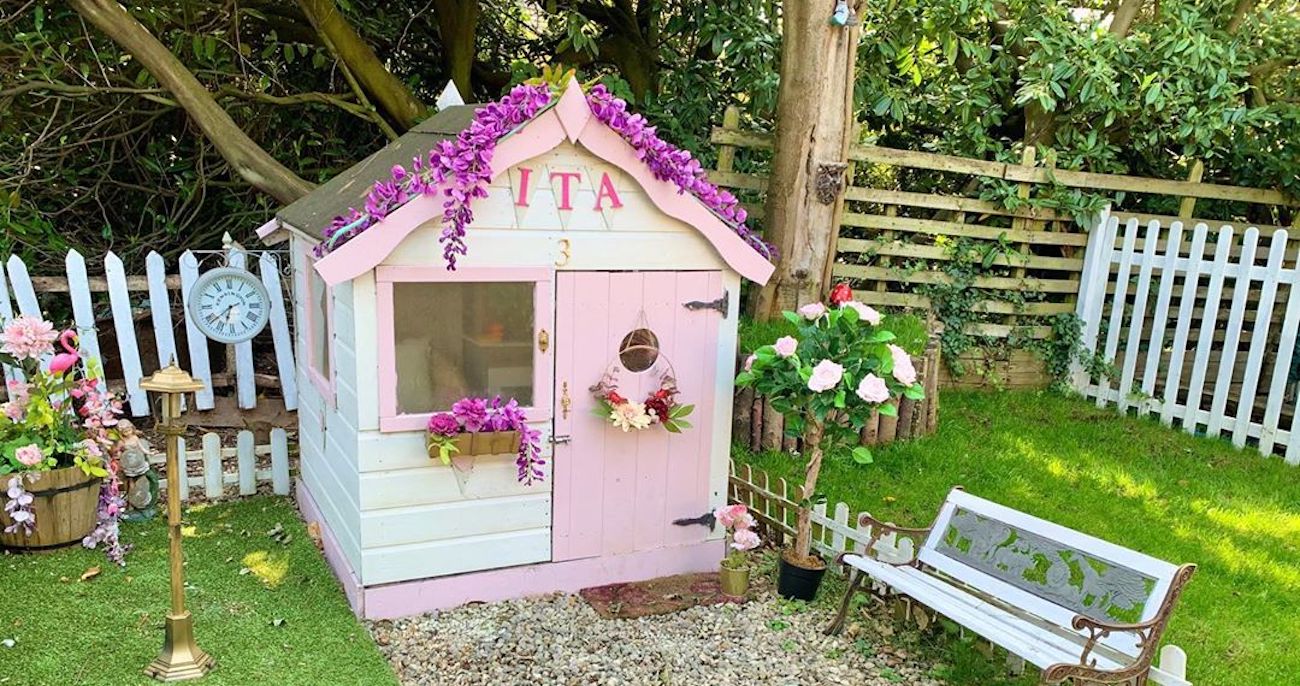
Customer image: @andrea.ita.garcia/
You now have all the information you need to choose the right playhouse for your family. Follow this guide and you’ll enjoy your new purchase for many happy years to come.
For more help choosing your perfect playhouse, call our sales experts on 0800 029 1000.
Additional resources:
- Find out how to build a base for your playhouse here: how to build a shed base.
- Waltons help pages
- Waltons blog
Browse our full range of wooden playhouses, summer houses, sheds, log cabins and garden rooms by visiting waltons.co.uk.


